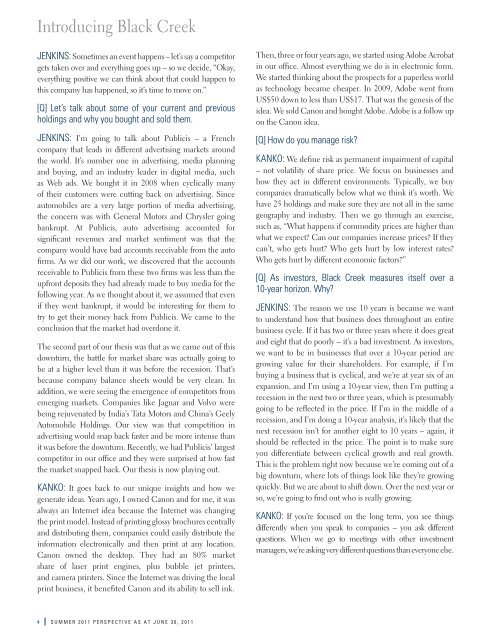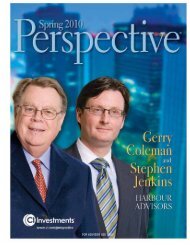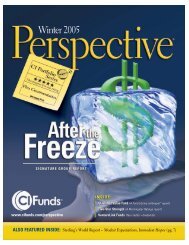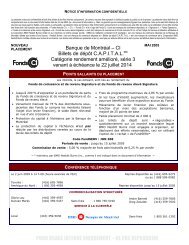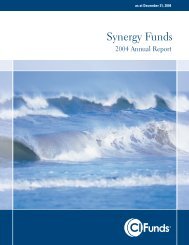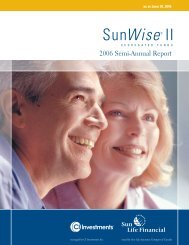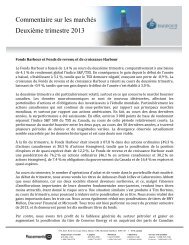July - Summer Edition - CI Investments
July - Summer Edition - CI Investments
July - Summer Edition - CI Investments
You also want an ePaper? Increase the reach of your titles
YUMPU automatically turns print PDFs into web optimized ePapers that Google loves.
Introducing Black Creek<br />
JENKINS: Sometimes an event happens – let’s say a competitor<br />
gets taken over and everything goes up – so we decide, “Okay,<br />
everything positive we can think about that could happen to<br />
this company has happened, so it’s time to move on.”<br />
[Q] Let’s talk about some of your current and previous<br />
holdings and why you bought and sold them.<br />
JENKINS: I’m going to talk about Publicis – a French<br />
company that leads in different advertising markets around<br />
the world. It’s number one in advertising, media planning<br />
and buying, and an industry leader in digital media, such<br />
as Web ads. We bought it in 2008 when cyclically many<br />
of their customers were cutting back on advertising. Since<br />
automobiles are a very large portion of media advertising,<br />
the concern was with General Motors and Chrysler going<br />
bankrupt. At Publicis, auto advertising accounted for<br />
significant revenues and market sentiment was that the<br />
company would have bad accounts receivable from the auto<br />
firms. As we did our work, we discovered that the accounts<br />
receivable to Publicis from these two firms was less than the<br />
upfront deposits they had already made to buy media for the<br />
following year. As we thought about it, we assumed that even<br />
if they went bankrupt, it would be interesting for them to<br />
try to get their money back from Publicis. We came to the<br />
conclusion that the market had overdone it.<br />
The second part of our thesis was that as we came out of this<br />
downturn, the battle for market share was actually going to<br />
be at a higher level than it was before the recession. That’s<br />
because company balance sheets would be very clean. In<br />
addition, we were seeing the emergence of competitors from<br />
emerging markets. Companies like Jaguar and Volvo were<br />
being rejuvenated by India’s Tata Motors and China’s Geely<br />
Automobile Holdings. Our view was that competition in<br />
advertising would snap back faster and be more intense than<br />
it was before the downturn. Recently, we had Publicis’ largest<br />
competitor in our office and they were surprised at how fast<br />
the market snapped back. Our thesis is now playing out.<br />
KANKO: It goes back to our unique insights and how we<br />
generate ideas. Years ago, I owned Canon and for me, it was<br />
always an Internet idea because the Internet was changing<br />
the print model. Instead of printing glossy brochures centrally<br />
and distributing them, companies could easily distribute the<br />
information electronically and then print at any location.<br />
Canon owned the desktop. They had an 80% market<br />
share of laser print engines, plus bubble jet printers,<br />
and camera printers. Since the Internet was driving the local<br />
print business, it benefited Canon and its ability to sell ink.<br />
Then, three or four years ago, we started using Adobe Acrobat<br />
in our office. Almost everything we do is in electronic form.<br />
We started thinking about the prospects for a paperless world<br />
as technology became cheaper. In 2009, Adobe went from<br />
US$50 down to less than US$17. That was the genesis of the<br />
idea. We sold Canon and bought Adobe. Adobe is a follow up<br />
on the Canon idea.<br />
[Q] How do you manage risk?<br />
KANKO: We define risk as permanent impairment of capital<br />
– not volatility of share price. We focus on businesses and<br />
how they act in different environments. Typically, we buy<br />
companies dramatically below what we think it’s worth. We<br />
have 25 holdings and make sure they are not all in the same<br />
geography and industry. Then we go through an exercise,<br />
such as, “What happens if commodity prices are higher than<br />
what we expect? Can our companies increase prices? If they<br />
can’t, who gets hurt? Who gets hurt by low interest rates?<br />
Who gets hurt by different economic factors?”<br />
[Q] As investors, Black Creek measures itself over a<br />
10-year horizon. Why?<br />
JENKINS: The reason we use 10 years is because we want<br />
to understand how that business does throughout an entire<br />
business cycle. If it has two or three years where it does great<br />
and eight that do poorly – it’s a bad investment. As investors,<br />
we want to be in businesses that over a 10-year period are<br />
growing value for their shareholders. For example, if I’m<br />
buying a business that is cyclical, and we’re at year six of an<br />
expansion, and I’m using a 10-year view, then I’m putting a<br />
recession in the next two or three years, which is presumably<br />
going to be reflected in the price. If I’m in the middle of a<br />
recession, and I’m doing a 10-year analysis, it’s likely that the<br />
next recession isn’t for another eight to 10 years – again, it<br />
should be reflected in the price. The point is to make sure<br />
you differentiate between cyclical growth and real growth.<br />
This is the problem right now because we’re coming out of a<br />
big downturn, where lots of things look like they’re growing<br />
quickly. But we are about to shift down. Over the next year or<br />
so, we’re going to find out who is really growing.<br />
KANKO: If you’re focused on the long term, you see things<br />
differently when you speak to companies – you ask different<br />
questions. When we go to meetings with other investment<br />
managers, we’re asking very different questions than everyone else.<br />
4 SUMMER 2011 PERSPECTIVE AS AT JUNE 30, 2011


